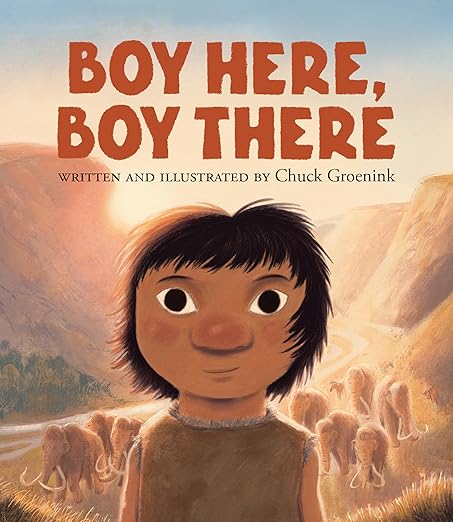Boy Here, Boy There

Boy Here, Boy There
The wide-open spaces shown on the pages of this oversize picture book provide the backdrop for an unusual introduction to life in prehistoric times.
Along with a small family group, a nameless Neanderthal boy lives in a peaceful mountainous area. They have been on the move and have now found home in a cave on a hill. The boy sets out to explore his new surroundings. His alert expressions indicate a curiosity about this place and the creatures that inhabit it.
First one step here, then another there.
Home behind, trees ahead, valley below
and bright river far away.
The boy encounters birds, insects and familiar-looking animals like bears and deer. There is even an array of what he refers to as “big hairies”. The illustration here is more than a little fantastical, not to say anachronistic, as there are representations of woolly mammoths, a rhinoceros, elephants and bison all moving past as one herd while the boy watches.
There is a lot of playfulness exhibited as the boy roams.
Running here, jumping, flying!
Falling? Rolling, rolling all the way,
Down there.
A more serious note is struck when he finds himself on a river bank, gazing across to another boy who looks eerily like him but for a shorter haircut and the garb of some later indigenous people.
Boy here.
Boy there.
Eyes here, nose, mouth there.
Eyes there, nose, mouth here.
Now there is an arresting wordless image of the two boys warily looking at each other from opposite sides of the water. Then the boy on the far bank is joined by his family.
Boy here, standing, looking.
Strangers there, moving on.
A hand is raised and disappears.
This glimpse into the future ends, and the boy’s day of adventuring comes full circle.
Home ahead, everywhere behind.
The boy decides to leave a memento of his passage by taking soot from the fire and using it to put handprints on the cave wall.
The author and illustrator (not a Canadian) has provided a text so brief and simple it reads more like free verse than prose. The illustrations, in appropriately muted green and sepia tones, are executed in gouache, pastel and charcoal. Many spreads emphasize the emptiness of a mostly unpopulated landscape, but there are endearing close-up views too. The last image, that of the sleeping family lying down with the wall covered in handprints of varying sizes above them, brings the story back to something very human and personal.
An extensive author’s note gives more information about Neanderthal civilization. Endpapers are decorated with images of stone tools.
Boy Here, Boy There is an interesting addition to primary fiction shelves in school and public libraries.
Ellen Heaney is a retired children’s librarian living in Coquitlam, British Columbia.
